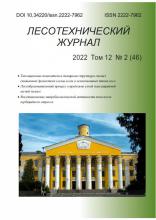Sankt-Peterburg, St. Petersburg, Russian Federation
Sankt-Peterburg, St. Petersburg, Russian Federation
The necessity of conducting intensive forestry is becoming more and more obvious challenge, due primarily to its low profitability. To increase the economic value of forest resources and obtaining long-term competitive advantage requires creation of products with added value. One of the objectives of proper forestry management as the basis of the forestry sector is to increase qualitative productivity of plants in the process of intensive forest growing. This relates to the improvement in the quality and quantity of all trees and each tree individually, as well as the properties of manufactured wood, which serve as the main criterion of successful work in different forest sector (forestry, woodworking, furniture, pulp and paper industries). Indicators such as the presence of knots, wood density, fiber length, etc. affect the quality of the final product and its cost. To improve the quality of formed wood is possible through repeated pruning of branches selected for further growth of the target trees; and productivity and marketability of plantings increases as a result of regular, timely, ongoing, intensive thinning and fertilizer application. These three silvicultural rules make comprehensive care for the forest. Comprehensive care for pine plantations in our country is mainly connected with the names of the scientists of the scientific school of Professor S. N. Sennov. The study was performed in forest stands after conducting a walk-through logging and introduction of nitrogen fertilizers. Pruning was not provided. Advanced technology of integrated care aimed at obtaining large sawlogs of high-grade, plywood and high-profile ridges with a high content of branchless wood and it is in earlier formation of the stand (with a specific density and spatial distribution of trees) – by an intensive cut in young trees of the I class of age of artificial or natural origin. After thinnings it is planned to make 3-times cutting of branches up to a height of 6 m (every 5 years), thinning, and advance thinning and 3-4-times application of nitrogen fertilizers. Thinning and fertilization is alternated in such a way that they do not coincide in time. Best time for fertilizers is 2-3 years after felling.
intensive forestry, comprehensive care for forest, thinning, pruning, fertilizer, wood quality
1. Antonov O.I. Vliyanie obrezki vetvey na ros tkultur i kachestvo drevesiny eli:dis. kand. s.-kh. nauk [Effect of Pruning on the Growth and the Quality Wood of Spruce Artificial Stands Dis PhD]. Sankt-Peterburg, 2000, 104 p. (In Russian). EDN: https://elibrary.ru/QDJCXB
2. Bezverhov P.V. Novyj sposob otvoda rubok uhoda s ispolzovaniem krugovyh ploshchadok izmenyaemogo radiusa. Materialymezhdunarodnojnauchno-prakticheskojkonferenciiSPbNIILH, 2011, 5 p. (In Russian). EDN: https://elibrary.ru/SXQJOF
3. Davyidov A.V. Vliyanie somknutosti nasazhdeniya I rubok uhoda za lesom na suchkovatost i formu stvolov [Influence Closeness Plantations and Thinning in the Branchiness and Bole Form]. Sb. trud."Rubkiuhodazalesom"[Proceedings "Thinning the Forest»]. Leningrad, 1940, pp. 5-49. (In Russian).
4. Melnikov E.S. Lesovodstvennyie osnovy i teorii i praktiki kompleksnogo uhoda za lesom: dis. dok. s.-kh. nauk [Silvicultural Foundations of the Theory and Practice of Complex Care for the Forest Dis DSc in Agriculture]. Sankt- Peterburg, 1999, 338 p. (In Russian).
5. Paavilajnen Je. Primenenie mineral'nyh udobrenij v lesu. [Use of mineral fertilizers in the forest] Moscow, 1986, 96 p. (In Russian).
6. Pekkoev A.N. Kachestvo drevesiny kul'tur eli pri uskorennom lesovyrashhivanii [The quality of wood of cultures ate during accelerated short term plantations] Lesnoy journal, 2016, no. 1. pp. 89-99. (In Russian).
7. Romanyuk B.D., Kudryashova A.M. Novye regionalnye normativy dlya intensivnoj i ustojchivoj modeli vedeniya lesnogo hozyajstva.[New regional standards for intensive and sustainable forest management, the economy] Sankt- Peterburg, 2009. (In Russian). EDN: https://elibrary.ru/QLBCXL
8. Starostin V.A. Vliyanie obrezki vetvey na rost kultur sosnyi: dis. kand. s.-kh. nauk [Effect of Pruning on the Growth of Pine Artificial Stands Dis PhD]. Leningrad, 1984, 110 p. (In Russian). EDN: https://elibrary.ru/NPOTZD
9. Stepanenko I.I. Vlijanie intensivnyh metodov lesovyrashhivanija s vneseniem mineral'nyh udobrenij na fizikomehanicheskie svojstva drevesiny sosny [Effect of intensive methods of forest cultivation with mineral fertilizers on the physico-mechanical properties of pine wood] Lesohozjajstvennaja informacija. [Forestry information] 2008, no. 5, pp. 3-10. (In Russian).
10. Axel R. Wirtschaftlichkeit der Wertastung. AllgemeineForstZeitschrift fur Waldwirtschaft und Umweltsorge, 1989, no 44-45, pp. 1188-1190.
11. Finnish Statistical Yearbook of Forestry. Metla, 2014.
12. Scholzke D. Die Astung von Fichtenbestanden in der Bundesrepublik Deutschland. «ForstundHolzwirt", 1982, no 12, pp. 307-308, 310, 312, 314.
13. Tonewood, Available at: http://www.tonewood.ch












